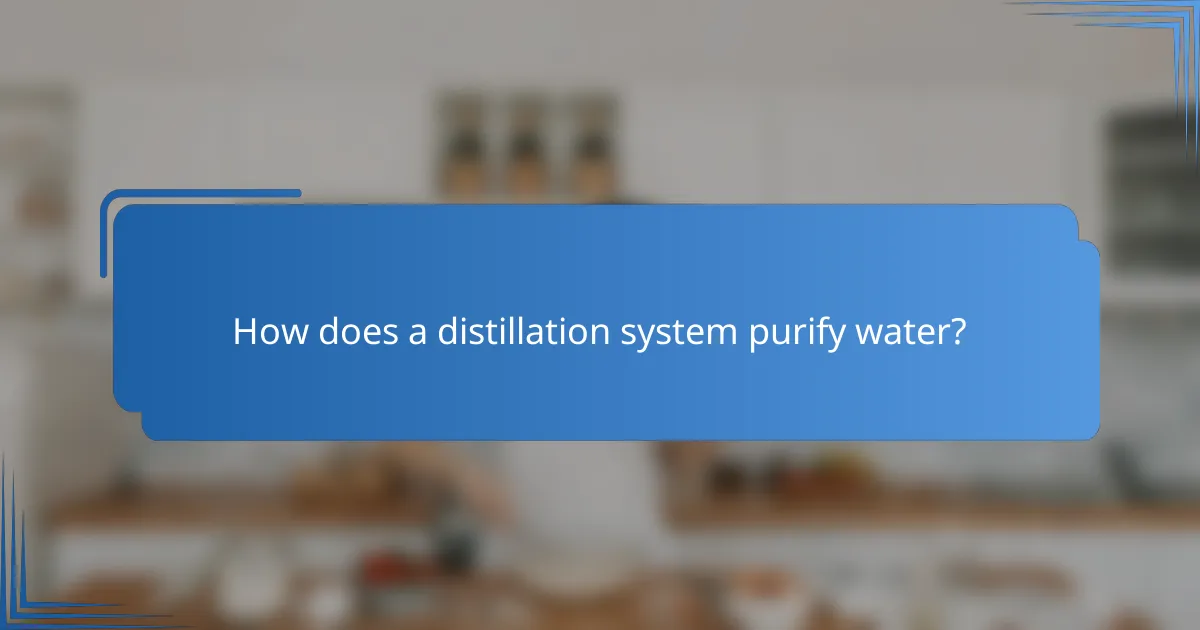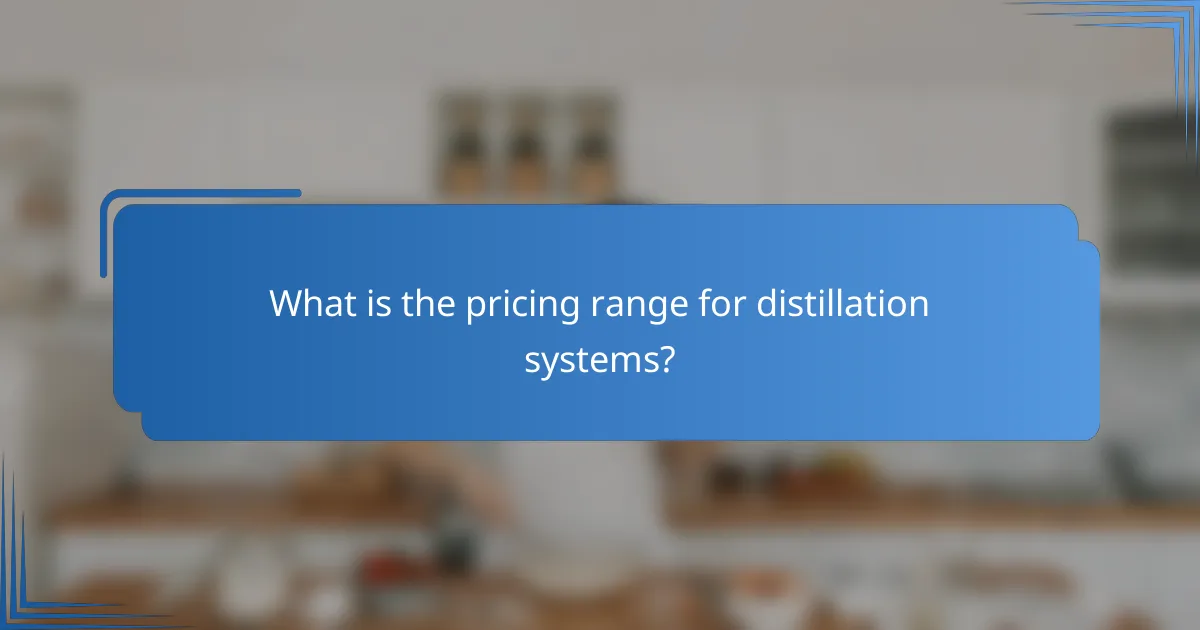A distillation system is an effective method for purifying water by heating it to create steam and then condensing that steam back into liquid form. This process successfully removes impurities, including harmful heavy metals like lead, arsenic, and mercury, ensuring the water is safe for consumption. With its reliable operation, a distillation system enhances water quality and provides a trustworthy solution for accessing clean drinking water.

How does a distillation system purify water?
A distillation system purifies water by heating it to create steam and then cooling the steam back into liquid form, effectively separating impurities. This process removes contaminants, including heavy metals, making the water safe for consumption.
Process of evaporation and condensation
The distillation process begins with evaporation, where water is heated until it transforms into steam. This steam rises and leaves behind impurities, as they do not evaporate at the same temperature.
Removal of contaminants
Distillation is effective at removing a wide range of contaminants, including heavy metals like lead and mercury, as well as salts and other dissolved solids. The high temperatures involved ensure that many harmful microorganisms are also eliminated.
However, some volatile organic compounds (VOCs) may not be completely removed, depending on their boiling points. Regular testing of the purified water is recommended to ensure safety and compliance with health standards.
Energy efficiency of systems
Energy efficiency in distillation systems can vary based on the technology used and the scale of operation. Traditional systems may consume significant energy, while modern, advanced units are designed to minimize energy use.
When selecting a distillation system, consider options like multi-effect distillation or vapor compression, which can enhance efficiency. Additionally, using renewable energy sources can further reduce operational costs and environmental impact.

What heavy metals can a distillation system remove?
A distillation system can effectively remove several heavy metals from water, including lead, arsenic, and mercury. These contaminants are harmful to health, and distillation works by boiling water and condensing the steam, leaving impurities behind.
Lead removal
Distillation is highly effective for lead removal, as lead has a higher boiling point than water. During the distillation process, water vaporizes and leaves lead and other heavy metals in the boiling chamber. This method can reduce lead levels significantly, often to undetectable amounts.
For optimal results, ensure that the distillation system is properly maintained and that the water source is tested regularly for lead contamination. Regular maintenance helps prevent any buildup of contaminants in the system itself.
Arsenic removal
Arsenic can also be effectively removed through distillation, as its boiling point is higher than that of water. When water is boiled, arsenic remains in the liquid phase, allowing for clean water to be collected from the vapor. This process can achieve high removal rates, making it a reliable option for arsenic-contaminated water.
To maximize arsenic removal, consider using a distillation system designed specifically for heavy metal removal. Regular testing of water post-distillation is advisable to ensure that arsenic levels are within safe limits.
Mercury removal
Mercury removal through distillation is effective due to its boiling point being higher than that of water. As the water evaporates, mercury remains in the distillation chamber, thus purifying the water. This method can achieve significant reductions in mercury levels.
It’s essential to monitor the distillation equipment for any signs of mercury buildup, as this can affect performance. Additionally, ensure that the system is compliant with local regulations regarding heavy metal removal to guarantee safety and effectiveness.

What are the benefits of using a distillation system?
A distillation system purifies water by boiling it and then condensing the steam back into liquid, effectively removing impurities, including heavy metals. This method not only enhances water quality but also provides a reliable solution for safe drinking water.
Improved water taste
Distillation significantly enhances the taste of water by eliminating contaminants that can cause unpleasant flavors. Many impurities, such as chlorine and certain minerals, can impart a distinct taste, which distillation effectively removes.
For those sensitive to taste, distilled water is often preferred for drinking and cooking. It can also improve the flavor of beverages like tea and coffee, as the absence of impurities allows the true flavors to shine through.
Enhanced safety for drinking
Using a distillation system greatly increases the safety of drinking water by removing harmful substances, including heavy metals like lead and mercury. This process ensures that the water is free from pathogens and chemical pollutants, making it safer for consumption.
In regions where water quality is a concern, distillation can be a vital tool for households. It provides peace of mind, knowing that the water consumed is purified and poses minimal health risks.
Low maintenance requirements
Distillation systems are generally low maintenance compared to other water purification methods. Most systems require minimal upkeep, such as regular cleaning of the boiling chamber and occasional replacement of filters, depending on the model.
Users can expect to spend less time and money on maintenance, making distillation a practical choice for those seeking a reliable water purification solution. Regular checks and simple cleaning routines can ensure long-term efficiency and effectiveness.

What are the top distillation systems available in the market?
The best distillation systems for purifying water and removing heavy metals vary in design and functionality. Key options include countertop models and larger systems, each with unique features that cater to different needs and budgets.
Waterwise 4000 Distiller
The Waterwise 4000 is a popular choice for home water purification. It operates by boiling water and collecting the steam, which condenses back into liquid, effectively removing contaminants including heavy metals.
This distiller can produce about 4 liters of distilled water in a single cycle, making it suitable for families or small households. It features an automatic shut-off for safety and is easy to clean, which adds to its reliability.
Megahome Countertop Water Distiller
The Megahome Countertop Water Distiller is known for its compact design and efficiency. It distills approximately 3.8 liters of water in about 5.5 hours, making it a practical option for daily use.
This model is user-friendly, with a simple one-button operation and a stainless steel interior that prevents contamination. It’s ideal for those who want a reliable system without taking up too much counter space.
Pure Water Mini-Classic CT
The Pure Water Mini-Classic CT is a high-quality distillation system designed for home use. It can produce around 3.8 liters of distilled water in about 6 hours, ensuring a steady supply of purified water.
This distiller features a glass collection container, which helps maintain water purity. Its durable construction and efficient operation make it a solid choice for individuals looking to remove heavy metals and other impurities from their drinking water.

How to choose the right distillation system?
Choosing the right distillation system involves evaluating your specific water purification needs, including the volume of water to be processed, energy efficiency, and the materials used in the system. A well-suited distillation system will effectively remove heavy metals and contaminants while being reliable and cost-effective in the long run.
Capacity considerations
When selecting a distillation system, consider the capacity required for your household or facility. Systems can range from small units designed for personal use, producing a few liters per day, to larger industrial systems capable of generating hundreds of liters daily. Assess your daily water needs to determine the appropriate size.
It’s also important to think about peak usage times. If you anticipate high demand during certain hours, choose a system that can handle those spikes without compromising water quality.
Energy consumption
Energy consumption is a critical factor in the long-term cost of operating a distillation system. Look for models that are energy-efficient, as they can significantly reduce electricity bills. Systems that utilize advanced heating technologies may consume less energy while maintaining effective purification.
Consider the energy source as well. Some systems may operate on electricity, while others can use gas or solar power, which might be more economical depending on local energy prices.
Material quality
The materials used in a distillation system directly impact its durability and effectiveness. Stainless steel is commonly preferred due to its resistance to corrosion and ability to withstand high temperatures. Ensure that any plastic components are food-grade and free from harmful chemicals.
Additionally, check for certifications that indicate compliance with safety and health standards. This can provide assurance that the materials used will not leach harmful substances into the distilled water.

What is the pricing range for distillation systems?
The pricing range for distillation systems varies significantly based on features and capacity, typically falling between a few hundred to several thousand dollars. Entry-level systems are more affordable, while advanced models with higher efficiency and additional features tend to be pricier.
Entry-level systems
Entry-level distillation systems generally cost between $200 and $600. These units are suitable for personal use and can effectively purify water by boiling it and condensing the steam, removing contaminants like heavy metals and bacteria.
When selecting an entry-level system, consider factors such as the water output capacity, energy consumption, and ease of maintenance. Many models are compact and designed for home use, making them convenient for small households.
Mid-range options
Mid-range distillation systems typically range from $600 to $1,500. These systems often offer larger capacities and more advanced features, such as multi-stage filtration and automated controls, which enhance their reliability and efficiency.
Investing in a mid-range system can be beneficial for larger families or those needing consistent water purification. Look for models that comply with safety standards and offer warranties, ensuring long-term reliability and support.
